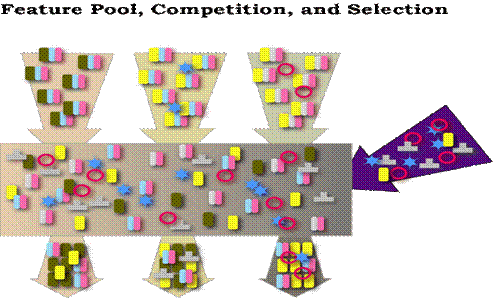The ‘Feature Pool’ Idea

This picture can be interpreted in various ways. The top tier represents input linguistic systems, which contribute features to the feature pool, in the middle tier. The lowest, third tier shows the output systems. The arrow to the right of the feature pool stands for non-native systems, which I have dubbed “xenolectal.” Assuming that the input and output varieties are all idiolects, the challenge is to figure out what principles (having to do with specific but varying ecological conditions of human interaction and with structural factors) regulate the selection of specific features into the output idiolects. One can also think of the input systems as dialects of the same language and of the arrow to the right of the feature pool as (a) separate language(s), artificially in abstraction of the idiolects that constitute them all. What particular principles govern the selection of their features (which would be characterized as “langagier” in French or as as “sprachlich” in German) into the output language varieties? Note that even if one sees such selections in terms of the elimination and retention of some the input varieties, the survivors are affected by the varieties that have been eliminated and thus win only a pyrrhic victory. One can also look at the picture more generally in terms of various languages competing for speakers in a multilingual setting. The question is which particular ecological factors favor one or some at the expense of the others, although the survivor(s) still win(s) a pyrrhic victory. If you are more curious now and don’t feel like reading The Ecology of Language Evolution yet, click here.(PDF File, Download PDF Viewer)